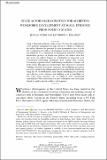State Actor Orchestration for Achieving Workforce Development at Scale: Evidence from Four US States
Author(s)
Myers, Jenna(Jenna E.); Kellogg, Katherine C.
DownloadAccepted version (1.179Mb)
Open Access Policy
Open Access Policy
Creative Commons Attribution-Noncommercial-Share Alike
Terms of use
Metadata
Show full item recordAbstract
Using a 20-month qualitative study of four US states that implemented career pathways spanning from high schools to colleges to employers, the authors illustrate the potential for state government actors to facilitate coordination of workforce development systems across geographies and industries. As a complement to explanations situated in workforce intermediary practices or formal state policies, the authors show that state actors can address barriers to coordination by using state actor orchestration—structuring provisional goal setting and revision, encouraging experimentation, and framing coordination to inspire collective action. This approach involves three types of practices: structural (building statewide governance structures and modifying governance processes), political (providing initial direction and piloting and broadening the set of stakeholders), and cultural (identifying key problems and collective action solutions and building social accountability for new roles). These practices vary according to states’ institutional environments: Where governance is more centralized, state actors gain latitude to guide regional workforce development.
Date issued
2020-07Department
Sloan School of ManagementJournal
Industrial & Labor Relations Review
Publisher
SAGE Publications
Citation
Myers, Jenna E. and Katherine C. Kellogg. "State Actor Orchestration for Achieving Workforce Development at Scale: Evidence from Four US States." Industrial & Labor Relations Review (July 2020): 1-28 © 2020 The Author(s)
Version: Author's final manuscript
ISSN
0019-7939
2162-271X